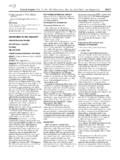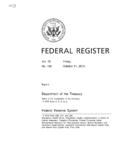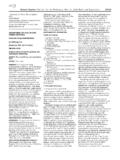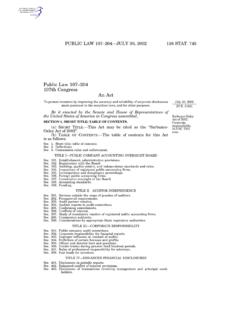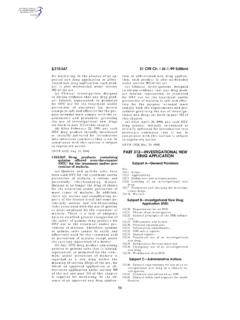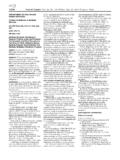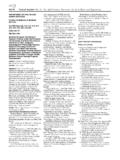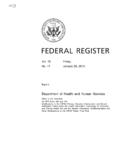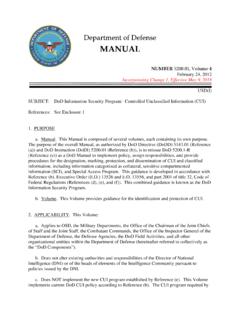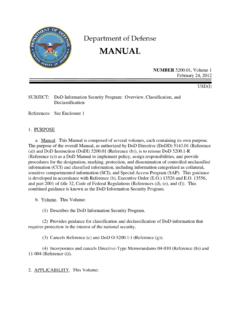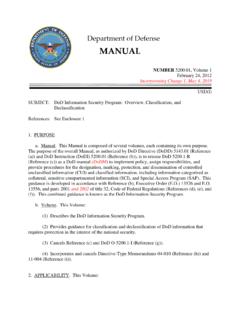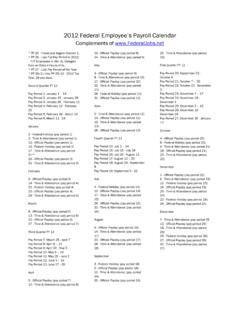Transcription of Federal Register /Vol. 77, No. 31/Wednesday, …
1 8725 Federal Register / Vol. 77, No. 31 / Wednesday, february 15, 2012 / Rules and Regulations 1 The HRSA Guidelines can be found at: http:// TABLEI Continued Year Limit Auto. proj. cost limit (Col. 1) Prior notice proj. cost limit (Col. 2) 2003 ..7,600,000 21,200,000 2004 ..7,800,000 21,600,000 2005 ..8,000,000 22,000,000 2006 ..9,600,000 27,400,000 2007 ..9,900,000 28,200,000 2008 ..10,200,000 29,000,000 2009 ..10,400,000 29,600,000 2010 ..10,500,000 29,900,000 2011 ..10,600,000 30,200,000 2012 ..10,800,000 30,800,000 * * * * * 3.
2 Table II in (a)(5) is revised to read as follows: Underground storage testing and development. (a) * * * (5) * * * TABLEII Year Limit 1982 ..$2,700,000 1983 ..2,900,000 1984 ..3,000,000 1985 ..3,100,000 1986 ..3,200,000 1987 ..3,300,000 1988 ..3,400,000 1989 ..3,500,000 1990 ..3,600,000 1991 ..3,800,000 1992 ..3,900,000 1993 ..4,000,000 1994 ..4,100,000 1995 ..4,200,000 1996 ..4,300,000 1997 ..4,400,000 1998 ..4,500,000 1999 ..4,550,000 2000 ..4,650,000 2001 ..4,750,000 2002 ..4,850,000 2003 ..4,900,000 2004 ..5,000,000 2005 ..5,100,000 2006 ..5,250,000 2007 ..5,400,000 2008 ..5,550,000 2009 ..5,600,000 2010 ..5,700,000 2011 ..5,750,000 2012 ..5,850,000 * * * * * [FR Doc. 2012 3488 Filed 2 14 12; 8:45 am] BILLING CODE 6717 01 P DEPARTMENT OF THE TREASURY Internal Revenue Service 26 CFR Part 54 [TD 9578] RIN 1545 BJ60 DEPARTMENT OF LABOR Employee Benefits Security Administration 29 CFR Part 2590 RIN 1210 AB44 DEPARTMENT OF HEALTH AND HUMAN SERVICES 45 CFR Part 147 [CMS 9992 F] RIN 0938 AQ74 Group Health Plans and Health Insurance Issuers Relating to Coverage of Preventive Services Under the Patient Protection and Affordable Care Act AGENCIES: Internal Revenue Service, Department of the Treasury; Employee Benefits Security Administration, Department of Labor; Centers for Medicare & Medicaid Services, Department of Health and Human Services.
3 ACTION: Final rules. SUMMARY: These regulations finalize, without change, interim final regulations authorizing the exemption of group health plans and group health insurance coverage sponsored by certain religious employers from having to cover certain preventive health services under provisions of the Patient Protection and Affordable Care Act. DATES: Effective date. These final regulations are effective on April 16, 2012 . Applicability dates. These final regulations generally apply to group health plans and group health insurance issuers on April 16, 2012 . FOR FURTHER INFORMATION CONTACT: Amy Turner or Beth Baum, Employee Benefits Security Administration (EBSA), Department of Labor, at (202) 693 8335; Karen Levin, Internal Revenue Service, Department of the Treasury, at (202) 622 6080; Robert Imes, Centers for Medicare & Medicaid Services (CMS), Department of Health and Human Services (HHS), at (410) 786 1565.
4 Customer Service Information: Individuals interested in obtaining information from the Department of Labor concerning employment-based health coverage laws may call the EBSA Toll-Free Hotline at 1 866 444 EBSA (3272) or visit the Department of Labor s Web site ( ). In addition, information from HHS on private health insurance for consumers can be found on the CMS Web site ( ), and on health reform can be found at http:// SUPPLEMENTARY INFORMATION: I. Background The Patient Protection and Affordable Care Act, Public Law 111 148, was enacted on March 23, 2010; the Health Care and Education Reconciliation Act of 2010, Public Law 111 152, was enacted on March 30, 2010 (collectively, the Affordable Care Act). The Affordable Care Act reorganizes, amends, and adds to the provisions of part A of title XXVII of the Public Health Service Act (PHS Act) relating to group health plans and health insurance issuers in the group and individual markets.
5 The Affordable Care Act adds section 715(a)(1) to the Employee Retirement Income Security Act (ERISA) and section 9815(a)(1) to the Internal Revenue Code (Code) to incorporate the provisions of part A of title XXVII of the PHS Act into ERISA and the Code, and make them applicable to group health plans. Section 2713 of the PHS Act, as added by the Affordable Care Act and incorporated into ERISA and the Code, requires that non-grandfathered group health plans and health insurance issuers offering group or individual health insurance coverage provide benefits for certain preventive health services without the imposition of cost sharing. These preventive health services include, with respect to women, preventive care and screening provided for in the comprehensive guidelines supported by the Health Resources and Services Administration (HRSA) that were issued on August 1, 2011 (HRSA Guidelines).
6 1As relevant here, the HRSA Guidelines require coverage, without cost sharing, for [a]ll Food and Drug Administration [(FDA)] approved contraceptive methods, sterilization procedures, and patient education and counseling for all women with reproductive capacity, as prescribed by a provider. Except as discussed below, non-grandfathered group health plans and health insurance issuers are required to provide coverage consistent with the HRSA Guidelines, without cost sharing, in plan years (or, VerDate Mar<15>2010 14:28 Feb 14, 2012 Jkt 226001 PO 00000 Frm 00009 Fmt 4700 Sfmt 4700 E:\FR\FM\ 15 FER1erowe on DSK2 VPTVN1 PROD with RULES8726 Federal Register / Vol. 77, No. 31 / Wednesday, february 15, 2012 / Rules and Regulations 2 The interim final regulations published by the Departments on July 19, 2010, generally provide that plans and issuers must cover a newly recommended preventive service starting with the first plan year (or, in the individual market, policy year) that begins on or after the date that is one year after the date on which the new recommendation or guideline is issued.)
7 26 CFR 2713T(b)(1); 29 CFR 2713(b)(1); 45 CFR (b)(1). 3 The amendment to the interim final regulations was published on August 3, 2011, at 76 FR 46621. in the individual market, policy years) beginning on or after August 1, These guidelines were based on recommendations of the independent Institute of Medicine, which undertook a review of the evidence on women s preventive services. The Departments of Health and Human Services, Labor, and the Treasury (the Departments) published interim final regulations implementing PHS Act section 2713 on July 19, 2010 (75 FR 41726). In the preamble to the interim final regulations, the Departments explained that HRSA was developing guidelines related to preventive care and screening for women that would be covered without cost sharing pursuant to PHS Act section 2713(a)(4), and that these guidelines were expected to be issued no later than August 1, 2011.
8 Although comments on the anticipated guidelines were not requested in the interim final regulations, the Departments received considerable feedback regarding which preventive services for women should be covered without cost sharing. Some commenters, including some religiously-affiliated employers, recommended that these guidelines include contraceptive services among the recommended women s preventive services and that the attendant coverage requirement apply to all group health plans and health insurance issuers. Other commenters, however, recommended that group health plans sponsored by religiously-affiliated employers be allowed to exclude contraceptive services from coverage under their plans if the employers deem such services contrary to their religious tenets, noting that some group health plans sponsored by organizations with a religious objection to contraceptives currently contain such exclusions for that reason.
9 In response to these comments, the Departments amended the interim final regulations to provide HRSA with discretion to establish an exemption for group health plans established or maintained by certain religious employers (and any group health insurance coverage provided in connection with such plans) with respect to any requirement to cover contraceptive services that they would otherwise be required to cover without cost sharing consistent with the HRSA Guidelines. The amended interim final regulations were issued and effective on August 1, amended interim final regulations specified that, for purposes of this exemption, a religious employer is one that: (1) Has the inculcation of religious values as its purpose; (2) primarily employs persons who share its religious tenets; (3) primarily serves persons who share its religious tenets; and (4) is a non-profit organization described in section 6033(a)(1) and section 6033(a)(3)(A)(i) or (iii) of the Code.
10 Section 6033(a)(3)(A)(i) and (iii) of the Code refers to churches, their integrated auxiliaries, and conventions or associations of churches, as well as to the exclusively religious activities of any religious order. In the HRSA Guidelines, HRSA exercised its discretion under the amended interim final regulations such that group health plans established and maintained by these religious employers (and any group health insurance coverage provided in connection with such plans) are not required to cover contraceptive services. In the preamble to the amended interim final regulations, the Departments explained that it was appropriate that HRSA take into account the religious beliefs of certain religious employers where coverage of contraceptive services is concerned. The Departments noted that a religious exemption is consistent with the policies in some States that currently both require contraceptive services coverage under State law and provide for some type of religious exemption from their contraceptive services coverage requirement.
